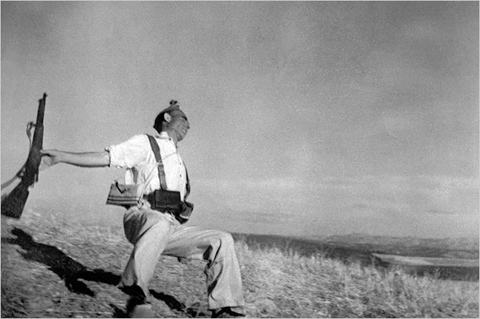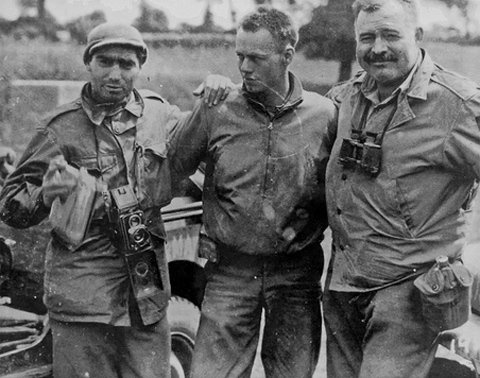
Falling Soldier — Robert Capa
I have always found something dubious about Robert Capa’s famous photograph of the falling soldier–it seemed like a Hollywood depiction of a man being blown off his feet by a bullet. Minus the squib. Where did the soldier get hit anyway? Can’t tell from the photograph.
Now, a researcher, José Manuel Susperregui, has concluded that the photograph was not taken where Capa claims it was, and in fact was made in an area that was not a battlefield at the time. That means, presumably, that Capa’s whole series of photos from the front was faked. Others counter that more research needs to be done.
Whatever.

Robert Capa and Ernest Hemingway
Capa’s falling soldier is a famous photograph because of the Capa mystique–the swashbuckling photojournalist, Republican partisan, romantically partnered with Gerda Taro, etc.
From the New York Times:
His fearlessness awed even his soldier subjects, and between battles he hung out with Hemingway and Steinbeck and usually drank too much, seeming to pull everything off with panache. William Saroyan wrote that he thought of Capa as “a poker player whose sideline was picture-taking.”
Capa, of course, went on to photograph D-Day in WWII, and died stepping on a landmine in Vietnam. None of that was faked. But strip away the Capa myth, and one is left pondering the image of the falling soldier. We are too close to see any context–no other soldiers, no evidence of a battlefield–only a grassy hillside and distant horizon defines the place. The soldier is hit–or so it seems–and starts to go down.
Capa famously said, “If your picture isn’t good enough, you’re not close enough.” In Falling Solder, he was too close. Perhaps too close politically as well. I doubt that we will ever know exactly what transpired on that hillside, and I’m not sure I really care. It’s a failed photograph.
Move along people–nothing to see here.